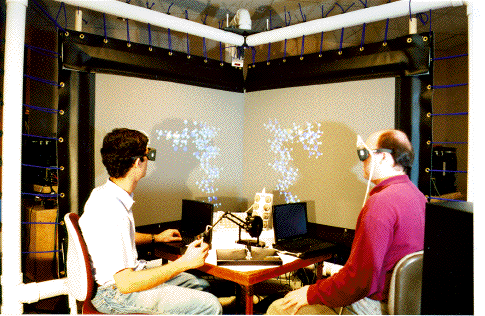Virtual Reality applied in Computer Aided Instruction
The CAVE and the Reality Theatre, two advanced facilities for Virtual Reality in the Smitsborg, offer a lot of new and exiting opportunities for research, development and least but not last for education and training. With VR techniques one can simulate virtual three-dimensional world in which you can move and interact. Simulated virtual worlds can be useful for training and education. 3D models can be used to illustrate spatial concepts.
Simulators can teach you how to fly an aeroplane, how to manoeuvre an oiltanker into the harbour of Rotterdam or how to drive an automobile within some urban environment. Chemical processes and compounds with interesting spatial aspects can be made clear. With medical simulators, medical professionals can practice difficult procedures such as entubation in a risk-free virtual environment. So far a few educational applications of VR, that will become a rich reservoir for future ideas.
A further step ahead
About 10 years ago, computer assisted instruction research was stimulated by the then new multimedia facilities of PC's. Nowadays every PC has these media facilities, which resulted in the development of electronic learning environments (ELO's) on a number of universities and colleges in The Netherlands around the year 2000. ELO's use photographs, sound and video, often consisting of images of practical situations.
With the arrival of VR facilities computer assisted instruction can make a further step ahead. In the virtual world, created with computer simulation, one can teach students certain skills. In the cockpit of an aeroplane, with a simulated environment as well as simulated movements of the plane, a pilot van is trained. Driving an automobile can also be simulated, by projecting the roadway and its environments in front of a car. Developments in the gaming industry applied in a virtual environment offer a lot of exiting opportunities for instruction.
Flight simulators are very expensive. But technical developments combined with mass production will make certain types of simulators affordable. For example driving simulators for automobile driving schools that are on the brink of entering the market of driving schools. Medical experts in hospitals are also interested in simulators to train nurses and other medical personnel certain cognitive and manual skills. There are already some medical simulators are on the market for affordable prices.
3D illustrations
VR can also be used to present and illustrate concepts. Textbooks only have two-dimensional illustrations of 3D objects. Often a 3D presentation of examples helps a lot in comprehension. A 3D visualisation of a chemical compound can be very clarifying.

